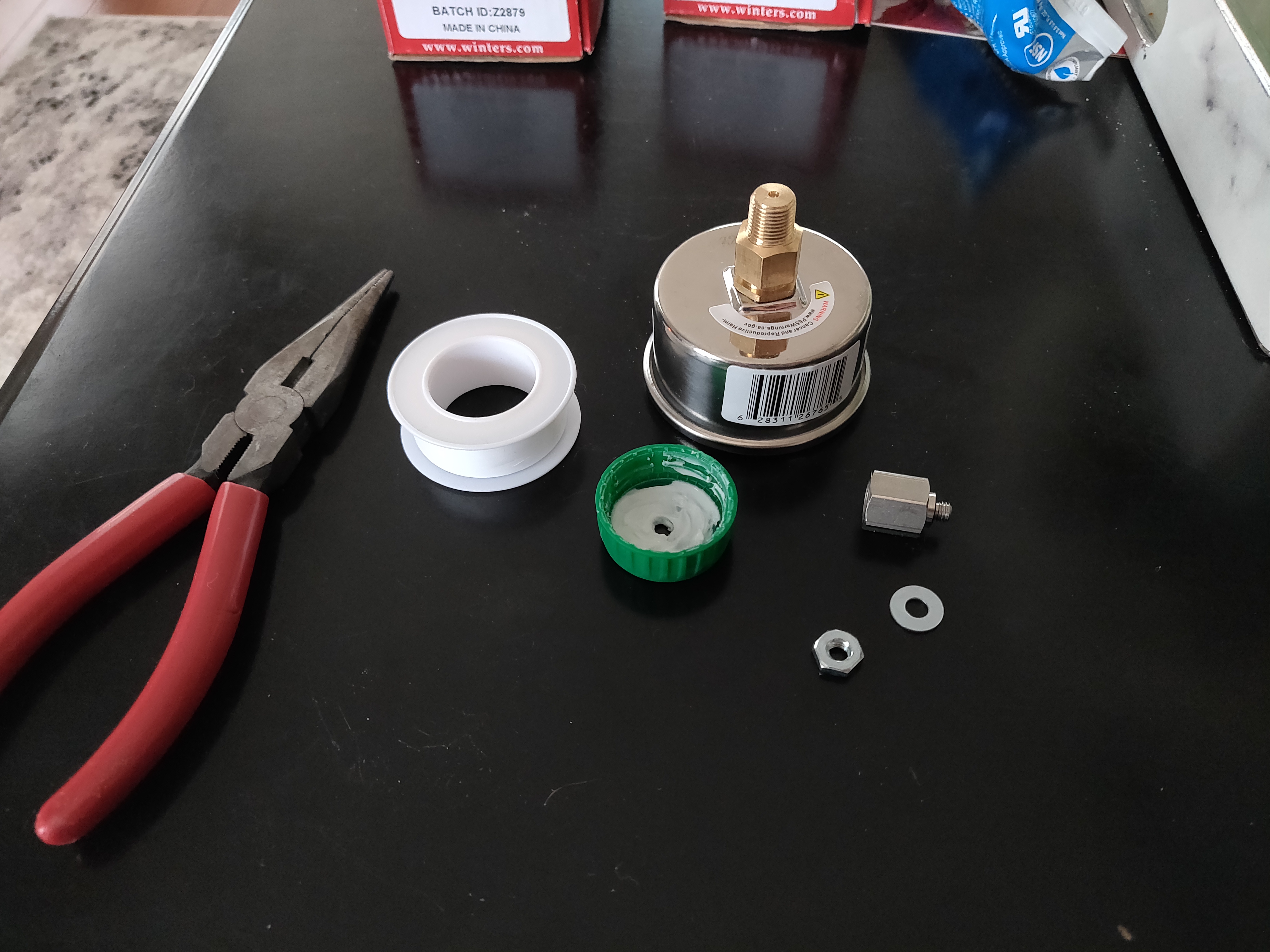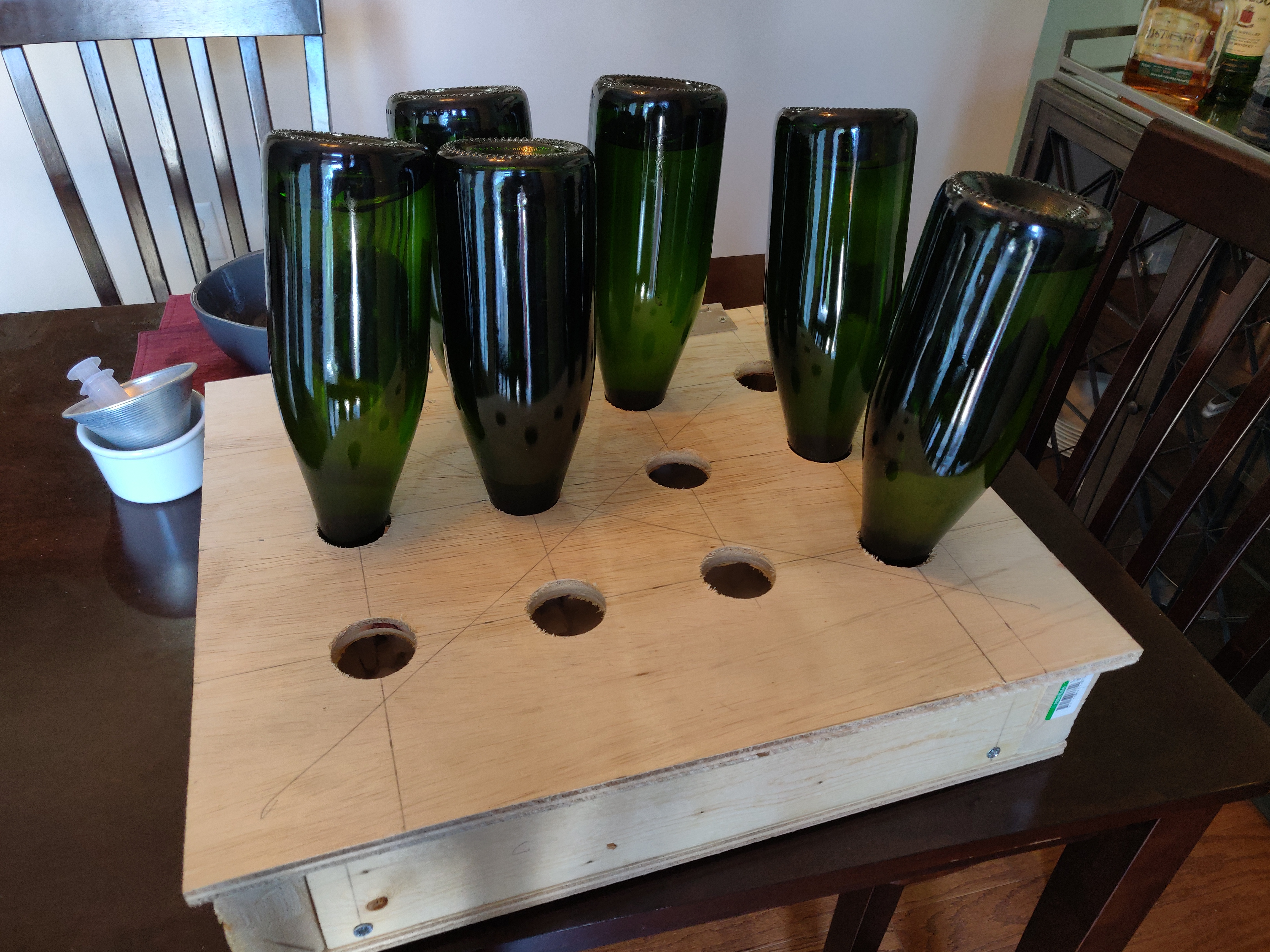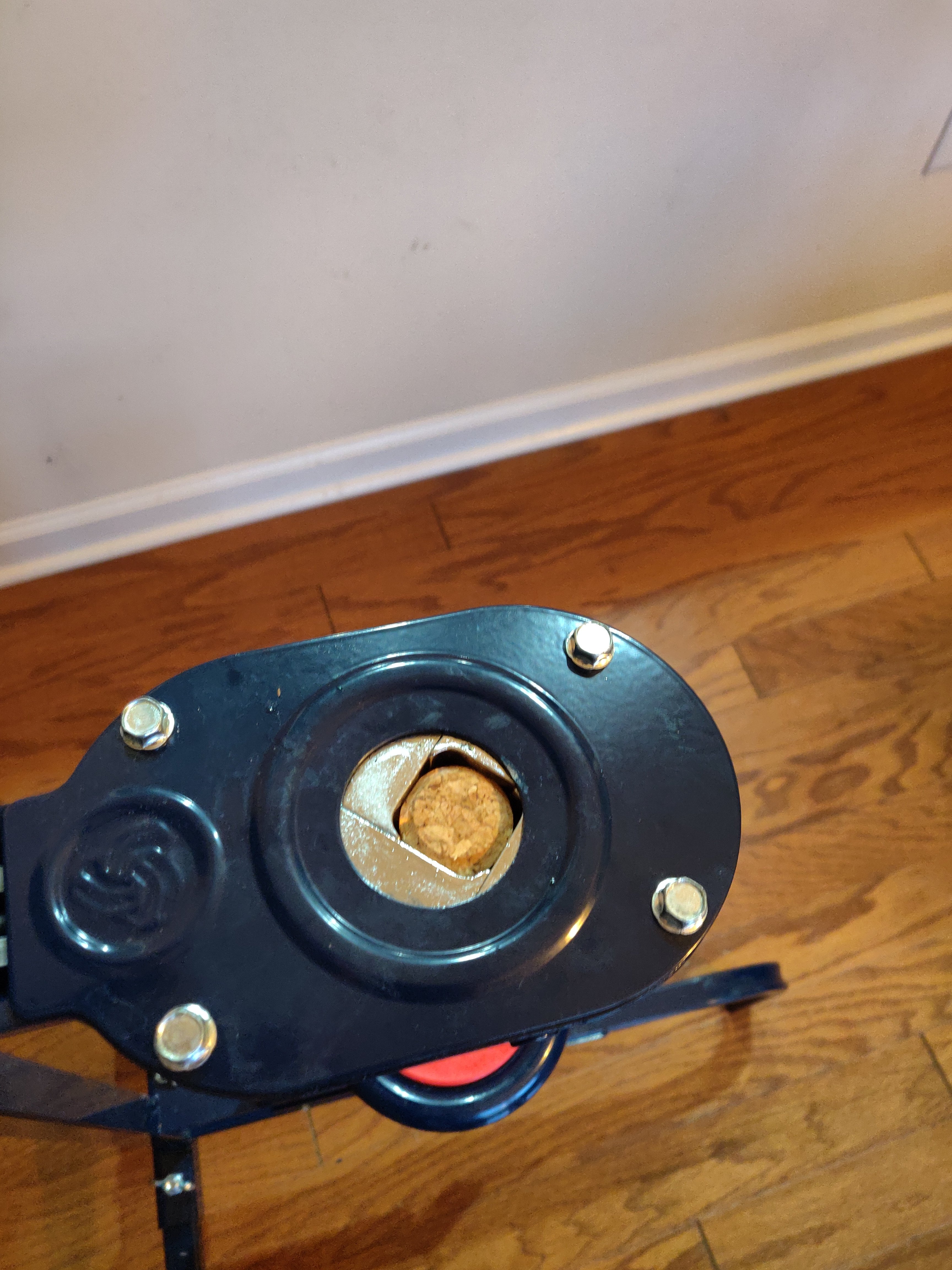Over this past year I completed a 10 gallon batch of sweet, sparkling, crystal clear cider. I wanted to give a rundown to how I accomplished this and some of the lessons I learned along the way.

The quick background is that I started with 10 gallons of juice which I fermented in 5 gallon buckets for ~2 weeks then racked over to glass carboys to sit for 3+ months to finish fermentation and clarify. At the end of this period I had dry crystal clear cider.
I needed to bottle this cider and I wanted bottles I know could be pressurized. I choose to go with European style sparkling wine bottles. This is where I learned my first lesson. American and European sparkling wines use slightly different bottles. American sparkling wine bottles have a 26mm mouth and can fit a standard beer bottle cap (which is an important note for later). They do not contain nearly as much glass as a standard European style bottle and therefore cannot be pressurized to as great of an extent. European bottles on the other hand can take pressures of 5+ ATM at room temperature. This is because they contain anywhere from 830-900g of glass. The other major difference is the mouth, which is 29mm and requires a larger crown cap and cork.
The second lesson I learned regarding these bottles is that not only do expensive Champagne producers use these European style bottles, but so do Cava producers or other French sparkling wine producers. Thus, if you cannot find a restaurant who will save them for you then its much cheaper to buy and drink Cava than Champagne.
I bottled each of the two 5 gallon batches at different pressures. 3 and 4 ATM, though Champagne is usually around 5 ATM. This was done to verify I was not going to over pressurize the bottles. I found 4.25g/L of dextrose to give about 1 ATM of pressure at room temp. I was able to determine this by fitting a pressure gauge into the cap of a PET bottle and filling it with some of the cider. You can find instructions for building this on this website.

The sparkling wine bottles were then capped with a 29mm crown cap. This must be done because you need to open the bottles later to remove the yeast in a process called disgorging. No cap or cork is 100% airtight, but I saw some leakage over time especially with the higher pressured bottles and would suggest really pushing down when capping to make sure that crown cap is completely sealed.
The bottles were left in wine boxes in a temperature controlled room to age on their side for 6 months. In this time the yeast uses all of the dextrose and falls to the bottom side of the bottle. In the Champagne method a step called riddling is required. This is usually a 21 day process of giving the bottles a quick quarter turn while slightly elevating the bottom of the bottle until the they are upright on their crown cap and all of the yeast has formed a solid mass on that crown cap. I did not waste my time with this for multiple reasons, namely I do not have a riddling rack. Instead I turned the bottles upright in their boxes. Then for 7 days I gave them a violent quarter turn and gently dropped them on their crown caps to shake the yeast to the bottom, which worked perfect for what I wanted to accomplish.
The next step is disgorging. You must start by chilling the cider/wine as cold as you can get it. Liquid will dissolve more CO2 at lower temperatures, resulting in less loss. In the normal process the bottle is quickly tilted from upside down to 45 degrees upright while simultaneously removing the crown cap. Then as soon as the yeast is expelled by the pressure you must put your thumb over the month of the bottle to stop any liquid losses. Obviously this is way too much to try to learn especially with only 5-10 gallon batches. Luckily there is a cheat. You can freeze some liquid in the neck of the bottle, turn the bottle to 45 degrees, remove the crown cap, and wait for the ice to melt enough to be ejected along with the yeast by the pressure. This is the method I chose. To freeze the necks I built a small box out of a 2x4 and some plywood which I filled with some crushed dry ice.


(Ice and yeast removed)
Now that you have a bottle without any yeast it can be sweetened. I choose to make one batch brute (10g/L sugar) and one batch a demi-sec (40g/L sugar). As this was my very first time trying this I decided to stabilize using sorbate as well. For the brute I created a 1:1 simple syrup by weight. For the demi-sec I did 2:1, otherwise there would be too much syrup to add to the bottles. I heated the water to dissolve the sorbate and sugar. I let it cool, then added in some potassium metabisulfite to help keep the cider from oxidizing. One thing I learned was to make at least 1 bottle's worth of extra syrup because there are usually some losses along the way. I used a syringe to inject the syrup down the side of the bottle. It is best to do this slowly at as close to 45 degrees as possible. This angle gives a larger surface area for the bubbles to disperse while also keeping the liquid in the bottle. Anyhow to verify I was injecting the right amount I weighed the syringe and compared it to the calculated weight (total weight of ingredients / # of bottles +1).
At this point the cider is drinkable and just needs to be corked. As mentioned bottle sizes are different and so are cork sizes. European style corks are 30mm wide by 47mm long. The only place I could find them online was through PIWine. They call them 3 piece #13 cork. They have a taper on one end and a flat side on the other. The flat end is the one which goes into the bottle. The tapered end hangs out of the top and is locked in by the cage. Another thing to note is that a special Champagne corker is required to put these into the bottle. These are easily found online.

I am going to be doing this again with this year's batch and think I worked out many of the kinks in the process. One thing I will be doing for sure is adding more pressure to the bottles. 3 ATM gave an ok mouth feel but the effervescence of the 4 ATM batch was much more enjoyable.

You can easily see the difference between the first picture (3ATM) and this one (4 ATM). Many more bubbles. I hope you all find this helpful.

The quick background is that I started with 10 gallons of juice which I fermented in 5 gallon buckets for ~2 weeks then racked over to glass carboys to sit for 3+ months to finish fermentation and clarify. At the end of this period I had dry crystal clear cider.
I needed to bottle this cider and I wanted bottles I know could be pressurized. I choose to go with European style sparkling wine bottles. This is where I learned my first lesson. American and European sparkling wines use slightly different bottles. American sparkling wine bottles have a 26mm mouth and can fit a standard beer bottle cap (which is an important note for later). They do not contain nearly as much glass as a standard European style bottle and therefore cannot be pressurized to as great of an extent. European bottles on the other hand can take pressures of 5+ ATM at room temperature. This is because they contain anywhere from 830-900g of glass. The other major difference is the mouth, which is 29mm and requires a larger crown cap and cork.
The second lesson I learned regarding these bottles is that not only do expensive Champagne producers use these European style bottles, but so do Cava producers or other French sparkling wine producers. Thus, if you cannot find a restaurant who will save them for you then its much cheaper to buy and drink Cava than Champagne.
I bottled each of the two 5 gallon batches at different pressures. 3 and 4 ATM, though Champagne is usually around 5 ATM. This was done to verify I was not going to over pressurize the bottles. I found 4.25g/L of dextrose to give about 1 ATM of pressure at room temp. I was able to determine this by fitting a pressure gauge into the cap of a PET bottle and filling it with some of the cider. You can find instructions for building this on this website.

The sparkling wine bottles were then capped with a 29mm crown cap. This must be done because you need to open the bottles later to remove the yeast in a process called disgorging. No cap or cork is 100% airtight, but I saw some leakage over time especially with the higher pressured bottles and would suggest really pushing down when capping to make sure that crown cap is completely sealed.
The bottles were left in wine boxes in a temperature controlled room to age on their side for 6 months. In this time the yeast uses all of the dextrose and falls to the bottom side of the bottle. In the Champagne method a step called riddling is required. This is usually a 21 day process of giving the bottles a quick quarter turn while slightly elevating the bottom of the bottle until the they are upright on their crown cap and all of the yeast has formed a solid mass on that crown cap. I did not waste my time with this for multiple reasons, namely I do not have a riddling rack. Instead I turned the bottles upright in their boxes. Then for 7 days I gave them a violent quarter turn and gently dropped them on their crown caps to shake the yeast to the bottom, which worked perfect for what I wanted to accomplish.
The next step is disgorging. You must start by chilling the cider/wine as cold as you can get it. Liquid will dissolve more CO2 at lower temperatures, resulting in less loss. In the normal process the bottle is quickly tilted from upside down to 45 degrees upright while simultaneously removing the crown cap. Then as soon as the yeast is expelled by the pressure you must put your thumb over the month of the bottle to stop any liquid losses. Obviously this is way too much to try to learn especially with only 5-10 gallon batches. Luckily there is a cheat. You can freeze some liquid in the neck of the bottle, turn the bottle to 45 degrees, remove the crown cap, and wait for the ice to melt enough to be ejected along with the yeast by the pressure. This is the method I chose. To freeze the necks I built a small box out of a 2x4 and some plywood which I filled with some crushed dry ice.


(Ice and yeast removed)
Now that you have a bottle without any yeast it can be sweetened. I choose to make one batch brute (10g/L sugar) and one batch a demi-sec (40g/L sugar). As this was my very first time trying this I decided to stabilize using sorbate as well. For the brute I created a 1:1 simple syrup by weight. For the demi-sec I did 2:1, otherwise there would be too much syrup to add to the bottles. I heated the water to dissolve the sorbate and sugar. I let it cool, then added in some potassium metabisulfite to help keep the cider from oxidizing. One thing I learned was to make at least 1 bottle's worth of extra syrup because there are usually some losses along the way. I used a syringe to inject the syrup down the side of the bottle. It is best to do this slowly at as close to 45 degrees as possible. This angle gives a larger surface area for the bubbles to disperse while also keeping the liquid in the bottle. Anyhow to verify I was injecting the right amount I weighed the syringe and compared it to the calculated weight (total weight of ingredients / # of bottles +1).
At this point the cider is drinkable and just needs to be corked. As mentioned bottle sizes are different and so are cork sizes. European style corks are 30mm wide by 47mm long. The only place I could find them online was through PIWine. They call them 3 piece #13 cork. They have a taper on one end and a flat side on the other. The flat end is the one which goes into the bottle. The tapered end hangs out of the top and is locked in by the cage. Another thing to note is that a special Champagne corker is required to put these into the bottle. These are easily found online.

I am going to be doing this again with this year's batch and think I worked out many of the kinks in the process. One thing I will be doing for sure is adding more pressure to the bottles. 3 ATM gave an ok mouth feel but the effervescence of the 4 ATM batch was much more enjoyable.

You can easily see the difference between the first picture (3ATM) and this one (4 ATM). Many more bubbles. I hope you all find this helpful.
Last edited:
























































![Craft A Brew - Safale S-04 Dry Yeast - Fermentis - English Ale Dry Yeast - For English and American Ales and Hard Apple Ciders - Ingredients for Home Brewing - Beer Making Supplies - [1 Pack]](https://m.media-amazon.com/images/I/41fVGNh6JfL._SL500_.jpg)

